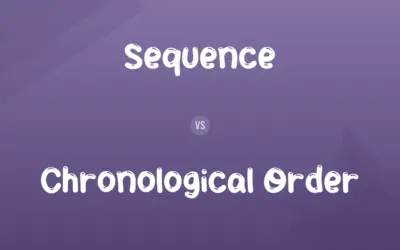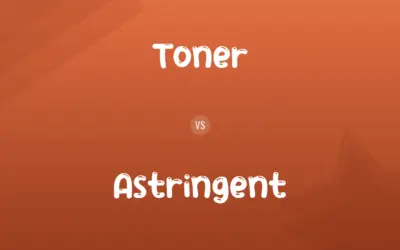Step Up Transformer vs. Step Down Transformer: Difference and Comparison
By Muazma Batool & Muneeza Rehman — Published on February 28, 2024
A step-up transformer increases voltage from primary to secondary coil, while a step-down transformer reduces it.

Difference Between Step Up Transformer and Step Down Transformer
Step-up transformers and step-down transformers are electrical devices designed to modify the voltage level of electricity flowing from one circuit to another through electromagnetic induction. The primary difference lies in their function: a step-up transformer increases the voltage from the primary coil (input) to the secondary coil (output), making it useful in applications where a higher voltage is needed from a low voltage source. Conversely, a step-down transformer decreases the voltage from the primary to the secondary coil, which is essential for reducing high voltages from power lines to a safer, usable level for home or industrial use.
Muazma Batool
Feb 28, 2024
The construction of both transformers is based on the principle of electromagnetic induction, with coils wound around a magnetic core. The number of windings in the primary and secondary coils determines whether the transformer will step up or step down the voltage. A step-up transformer has more windings on the secondary coil than on the primary coil, whereas a step-down transformer has fewer windings on the secondary coil compared to the primary.
Muazma Batool
Feb 28, 2024
The application of these transformers reflects their functional differences. Step-up transformers are commonly used in power transmission to increase voltage for efficient long-distance transmission with reduced loss, while step-down transformers are widely used in distribution systems to lower the voltage for consumer use. This ensures that electrical appliances receive electricity at a safe and usable voltage level.
Muazma Batool
Feb 28, 2024
Efficiency is a critical factor for both types of transformers. While they are designed to minimize energy loss, some energy is inevitably lost as heat due to resistance in the coils. The design and materials used in transformers are optimized to reduce these losses, making the process of voltage transformation as efficient as possible.
Henry
Feb 28, 2024
Understanding the distinction between step-up and step-down transformers is essential for their correct application in electrical systems. By matching the transformer to the specific needs of a system, engineers can ensure that electrical energy is transmitted and used efficiently and safely.
Muazma Batool
Feb 28, 2024
Step Up Transformer vs. Step Down Transformer Comparison Chart
Function
Increases voltage from primary to secondary coil.
Decreases voltage from primary to secondary coil.
Muazma Batool
Feb 28, 2024
Coil Windings
More windings on the secondary coil than the primary.
Fewer windings on the secondary coil than the primary.
Muazma Batool
Feb 28, 2024
Application
Used to raise voltage for long-distance power transmission.
Used to reduce voltage for safe consumer or industrial use.
Muazma Batool
Feb 28, 2024
Efficiency
Designed to maximize efficiency, though some energy is lost as heat.
Similarly aims for high efficiency, with minimal energy lost to heat.
Muazma Batool
Feb 28, 2024
Example Use
Connecting power plants to high-voltage transmission lines.
Bringing high-voltage electricity from power lines into homes or businesses.
Elijah
Feb 28, 2024
Step Up Transformer vs. Step Down Transformer Definitions
◉Step Up Transformer
Characterized by a greater number of turns in the secondary coil.
The step-up transformer's secondary coil has significantly more windings than its primary.
Muazma Batool
Feb 22, 2024
◉Step Down Transformer
Converts higher voltage to lower voltage.
Step-down transformers make it possible to utilize high-voltage energy in low-voltage environments.
Levi
Feb 22, 2024
◉Step Up Transformer
Focuses on reducing power loss over long distances.
By stepping up voltage, the transformer reduces energy loss during transmission.
Muazma Batool
Feb 22, 2024
◉Step Down Transformer
An electrical device that decreases voltage from input to output.
Homes are equipped with step-down transformers to convert incoming high voltage to a safer level.
Muazma Batool
Feb 22, 2024
◉Step Up Transformer
Converts lower voltage to higher voltage.
Step-up transformers are used to adapt low-voltage energy for high-voltage systems.
Muazma Batool
Feb 22, 2024
◉Step Down Transformer
Crucial for the safety and functionality of household and industrial devices.
Without step-down transformers, common appliances would not be able to function safely.
Muazma Batool
Feb 22, 2024
◉Step Up Transformer
An electrical device that increases voltage from input to output.
The power station uses a step-up transformer to increase voltage for transmission.
Muazma Batool
Feb 22, 2024
◉Step Down Transformer
Aims to deliver electricity safely and efficiently to end-users.
Step-down transformers are designed for minimal energy loss in consumer applications.
Muazma Batool
Feb 22, 2024
◉Step Up Transformer
Essential in the initial stages of electrical power distribution.
Step-up transformers are crucial for efficient power transmission to remote areas.
Nolan
Feb 22, 2024
◉Step Down Transformer
Has fewer windings on the secondary coil compared to the primary.
The step-down transformer's design includes fewer secondary coil windings to reduce voltage.
Muazma Batool
Feb 22, 2024
Step Up Transformer vs. Step Down Transformer Frequently Asked Questions
Can the efficiency of transformers vary?
Yes, efficiency can vary based on design, materials, and the specific application, but it's generally high to minimize energy loss.
Muazma Batool
Feb 28, 2024
Why are step-up transformers used in power transmission?
They increase voltage to reduce energy loss over long distances, making power transmission more efficient.
Muazma Batool
Feb 28, 2024
Are transformers used in both residential and commercial settings?
Yes, transformers are used in both settings, with step-down transformers being particularly important for adapting high-voltage electricity for safe, everyday use.
William
Feb 28, 2024
Can a single transformer both step up and step down voltage?
A transformer is designed for one function or the other, not both, due to the specific arrangement of coil windings.
Levi
Feb 28, 2024
How is the voltage ratio of a transformer determined?
The voltage ratio is determined by the ratio of the number of windings in the secondary coil to the number of windings in the primary coil.
Jonathan
Feb 28, 2024
Why does a step-up transformer have more windings on the secondary coil?
More windings on the secondary coil increase the voltage output, which is the primary function of a step-up transformer.
Nolan
Feb 28, 2024
What role do step-down transformers play in everyday electrical appliances?
They convert the high voltage from power lines to the lower voltage required by most electrical appliances, ensuring their safe operation.
Leo
Feb 28, 2024
How does a step-down transformer enhance safety?
It reduces the high voltage of electrical power to a lower, safer level suitable for household and industrial use.
Muazma Batool
Feb 28, 2024
How do transformers contribute to energy efficiency in the electrical grid?
By adjusting voltage levels for optimal transmission and use, transformers reduce energy loss, contributing to overall grid efficiency.
Muazma Batool
Feb 28, 2024
What materials are used in transformer construction to minimize energy loss?
High-quality conductive materials for coils and magnetic cores with low hysteresis loss are used to minimize energy loss.
Kaitlyn
Feb 28, 2024
Content Creators
Written by
Muazma BatoolAs a content editor, Muazma Batool is not just a grammar guru but a creative mastermind who breathes life into every word. With an eagle eye for detail and a passion for storytelling, she transforms bland text into engaging content that captivates audiences and drives results.
Co-written by
Muneeza RehmanAt Comparisons.wiki, Muneeza skillfully navigates the vast sea of information, ensuring clarity and accuracy as the lead content editor. With a keen eye for detail, she curates every comparison to enlighten and engage readers.


































